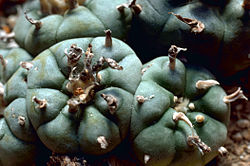
Back صبار وليمز Arabic صبار وليمز ARZ Lophophora williamsii AST Пейот Bulgarian Peiot Catalan Lophophora williamsii CEB Lofofora Williamsova Czech Elefantfodkaktus Danish Lophophora williamsii German Πεγιότ Greek
| Peyote | |
|---|---|

| |
| Peyote in the wild | |
| Scientific classification | |
| Kingdom: | Plantae |
| Clade: | Tracheophytes |
| Clade: | Angiosperms |
| Clade: | Eudicots |
| Order: | Caryophyllales |
| Family: | Cactaceae |
| Subfamily: | Cactoideae |
| Genus: | Lophophora |
| Species: | L. williamsii
|
| Binomial name | |
| Lophophora williamsii (Lem. ex J.F.Cels) J.M.Coult.
| |
| Synonyms | |
|
Echinocactus williamsii Lemaire ex Salm-Dyck | |
The peyote (/peɪˈoʊti/; Lophophora williamsii /ləˈfɒfərə wɪliˈæmziaɪ/) is a small, spineless cactus which contains psychoactive alkaloids,[2] particularly mescaline.[3] Peyote is a Spanish word derived from the Nahuatl peyōtl ([ˈpejoːt͡ɬ]), meaning "caterpillar cocoon", from a root peyōni, "to glisten".[4][5][6]
It is native to southern North America, primarily found in desert scrub and limestone-rich areas of northern Mexico and south Texas, particularly in the Chihuahuan Desert at elevations of 100–1500 meters. It flowers from March to May, and sometimes as late as September. Its flowers are pink or white, with thigmotactic anthers (like Opuntia). It is a small, spineless cactus that grows in clusters, produces edible fruits, and contains psychoactive alkaloids—primarily mescaline—at concentrations of about 0.4% when fresh and up to 6% when dried.
Peyote is a slow-growing cactus that can be cultivated more rapidly through techniques such as grafting, and while wild populations in regions like south Texas have declined due to harvesting, cultivation, and the use of alternatives like San Pedro are being explored as potential conservation approaches.
It has been used for over 5,000 years by Indigenous peoples of the Americas for ceremonial, spiritual, and folk medicine purposes. Its effects last up to 12 hours. The Native American Church considers peyote a sacred sacrament used in all-night healing ceremonies to connect with the spiritual world and often personifies peyote as a divine spirit akin to Jesus. In Wixarika (Huichol) culture, peyote is considered the soul of their religion and a visionary sacrament that connects them to their principal deities — corn, deer, peyote, and the eagle. Peyote and its psychoactive component mescaline are generally controlled substances worldwide, but many laws—including in Canada and the United States—exempt its use in authentic Native American religious ceremonies, with U.S. federal law and some states allowing such ceremonial use regardless of race.
- ^ Terry, M. (2017). "Lophophora williamsii". IUCN Red List of Threatened Species. 2017: e.T151962A121515326. doi:10.2305/IUCN.UK.2017-3.RLTS.T151962A121515326.en. Retrieved 19 November 2021.
- ^ Bauer, Barbara E. (2021-11-01). "The Compounds in Psychedelic Cacti". Psychedelic Science Review. Retrieved 2022-04-01.
- ^ Salak, Kira. "Lost Souls of the Peyote Trail (published in National Geographic Adventure)". Kira Salak. Kira Salak, KiraSalak.com. Retrieved 2013-09-12.
- ^ Other sources, apparently incorrectly, translate the Nahuatl word as "divine messenger". Anderson, Edward F. (2001). The Cactus Family. Pentland, Oregon: Timber Press. ISBN 978-0-88192-498-5. p. 396.
- ^ "Peyote". The American Heritage Dictionary of the English Language. Houghton Mifflin Harcourt Publishing Company. 2020.
- ^ Andrews, J. Richard (2003). Workbook for Introduction to Classical Nahuatl, Revised Edition. University of Oklahoma Press. ISBN 978-0-8061-3453-6. p. 246. See peyotl in Wiktionary.
© MMXXIII Rich X Search. We shall prevail. All rights reserved. Rich X Search
